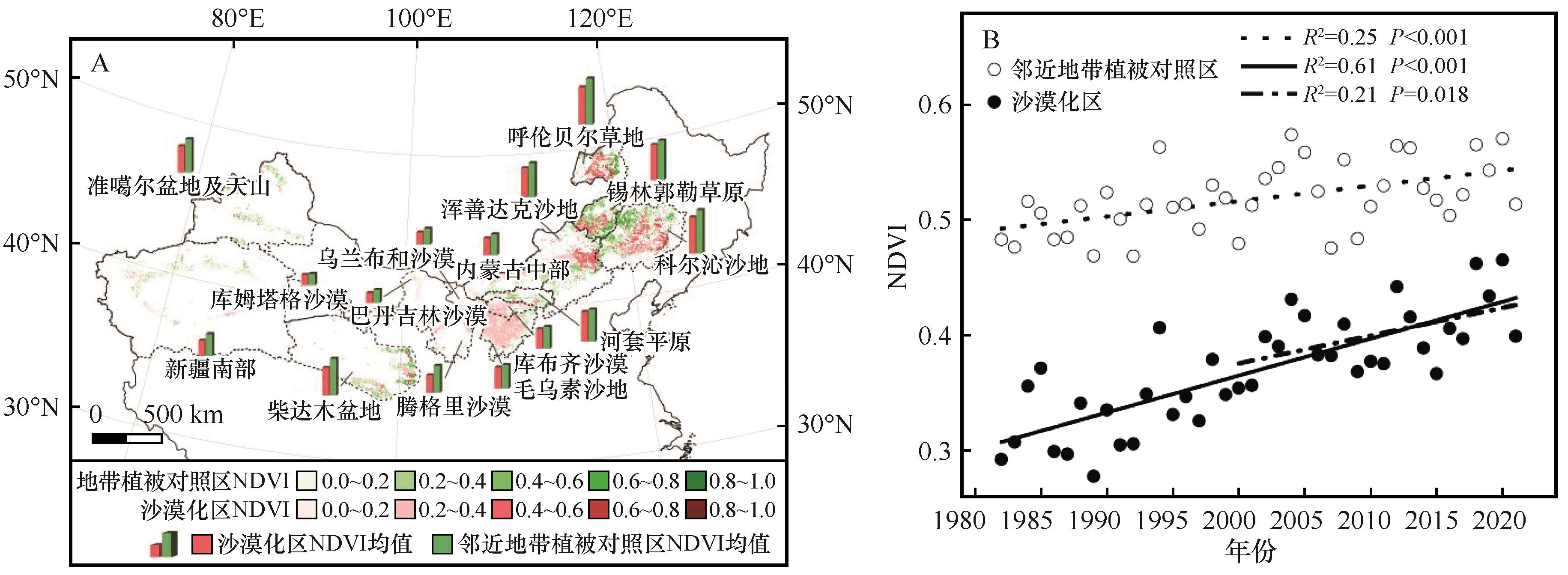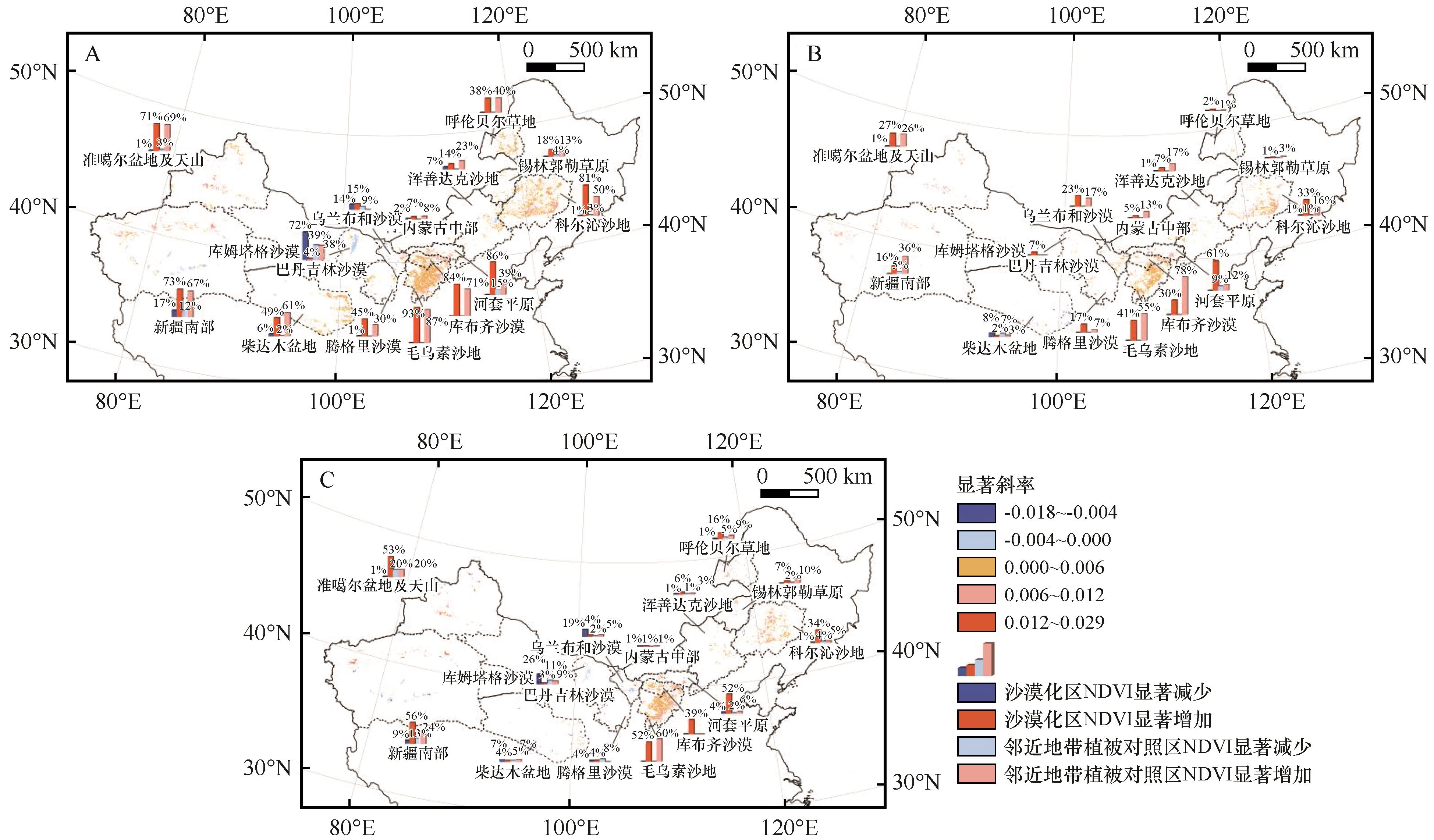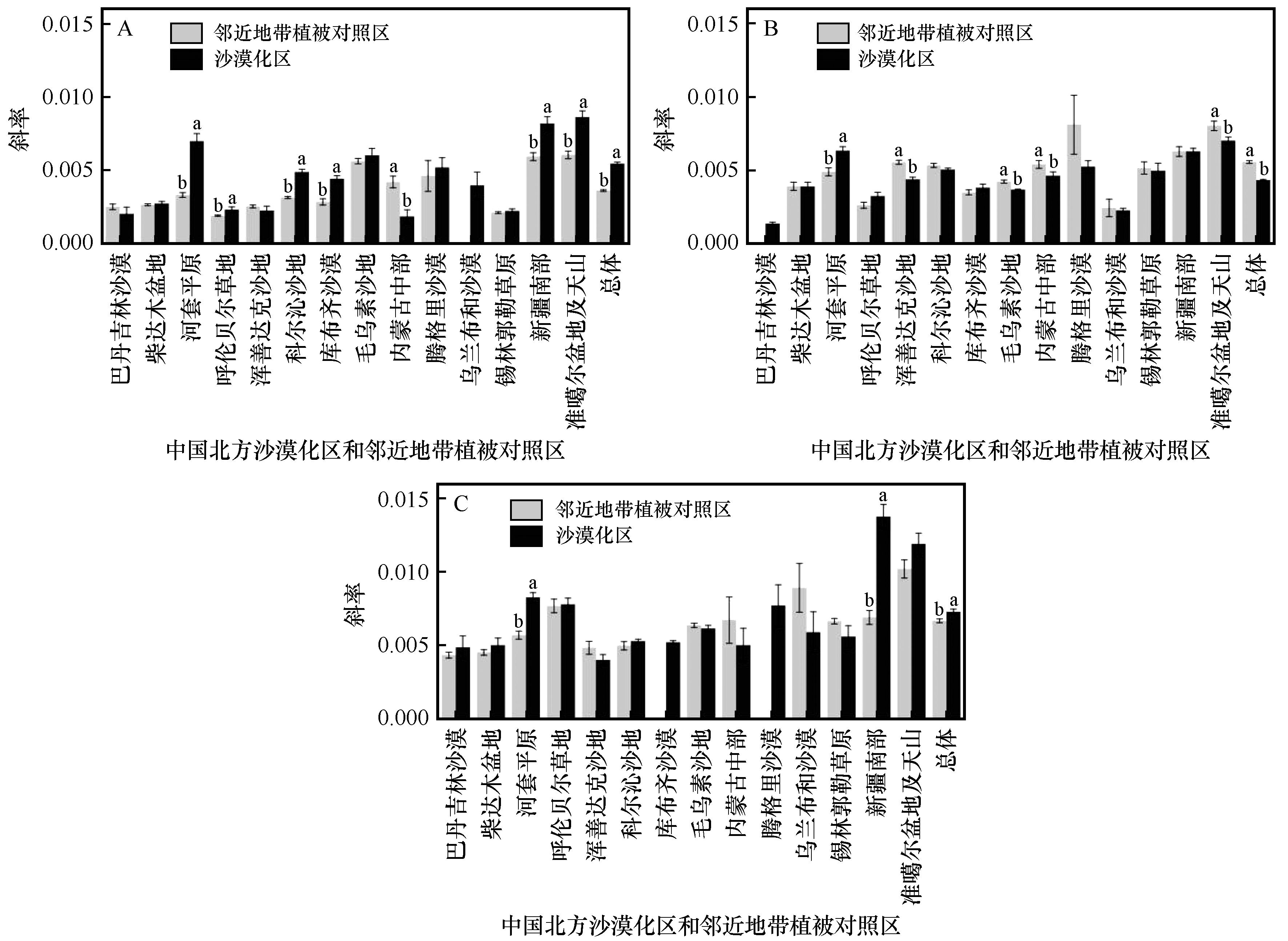
- CN 62-1070/P
- ISSN 1000-694X
- Bimonthly 1981

Journal of Desert Research ›› 2023, Vol. 43 ›› Issue (5): 204-213.DOI: 10.7522/j.issn.1000-694X.2023.000112
Junhao Liu1,3( ), Haisheng Zhou1,3, Qun Guo1,2,4(
), Haisheng Zhou1,3, Qun Guo1,2,4( )
)
Received:2023-06-22
Revised:2023-08-23
Online:2023-09-20
Published:2023-09-27
Contact:
Qun Guo
CLC Number:
Junhao Liu, Haisheng Zhou, Qun Guo. The effects of desertification control on the patterns of vegetation in arid and semi-arid regions of northern China[J]. Journal of Desert Research, 2023, 43(5): 204-213.
Add to citation manager EndNote|Ris|BibTeX
URL: http://www.desert.ac.cn/EN/10.7522/j.issn.1000-694X.2023.000112

Fig.3 Spatial (A) and temporal (B) patterns of mean values of annual NDVI maxima in desertification areas and adjacent zonal vegetation in northern China from 1982 to 2021

Fig.4 Spatial distribution of changing rates of NDVI in the desertification and adjacent zonal vegetation in northern China from 1982 to 2021 (A), before 2000 (B) and after 2000 (C)

Fig.5 Comparison of NDVI increase rates in desertification and adjacent zonal vegetation in northern China from 1982 to 2021 (A), before 2000 (B) and after 2000 (C)
| 1 | Chen C, Park T, Wang X,et al.China and India lead in greening of the world through land-use management[J].Nature Sustainability,2019,2(2):122-129. |
| 2 | 李成,杨舒慧,吴芳,等.“双碳”背景下中国能源消费碳排放与植被固碳的时空分异[J].中国环境科学,2022,42(4):1945-1953. |
| 3 | Piao S, Wang X, Park T,et al.Characteristics,drivers and feedbacks of global greening[J].Nature Reviews Earth & Environment,2020,1(1):14-27. |
| 4 | Hua W, Chen H, Zhou L,et al.Observational quantification of climatic and human influences on vegetation greening in China[J].Remote Sensing,2017,9(5):425. |
| 5 | Lu F, Hu H, Sun W,et al.Effects of national ecological restoration projects on carbon sequestration in China from 2001 to 2010[J].Proceedings of the National Academy of Sciences,2018,115(16):4039-4044. |
| 6 | Niu Q, Xiao X, Zhang Y,et al.Ecological engineering projects increased vegetation cover,production,and biomass in semiarid and subhumid northern China[J].Land Degradation & Development,2019,30(13):1620-1631. |
| 7 | Chen Y, Feng X, Tian H,et al.Accelerated increase in vegetation carbon sequestration in China after 2010: a turning point resulting from climate and human interaction[J].Global Change Biology,2021,27(22):5848-5864. |
| 8 | Liu Z, Wang J, Wang X,et al.Understanding the impacts of 'Grain for Green' land management practice on land greening dynamics over the Loess Plateau of China[J].Land Use Policy,2020,99:105084. |
| 9 | 昝国盛,王翠萍,李锋,等.第六次全国荒漠化和沙化调查主要结果及分析[J].林业资源管理,2023(1):1-7. |
| 10 | 罗琦,甄霖,杨婉妮,等.生态治理工程对锡林郭勒草地生态系统文化服务感知的影响研究[J].自然资源学报,2020,35(1):119-129. |
| 11 | 赵文智,白雪莲,刘婵.巴丹吉林沙漠南缘的植物固沙问题[J].中国沙漠,2022,42(1):5-11. |
| 12 | Di K, Hu Z, Wang M,et al.Recent greening of grasslands in northern China driven by increasing precipitation[J].Journal of Plant Ecology,2021,14(5):843-853. |
| 13 | Zhao W, Yu X, Jiao C,et al.Increased association between climate change and vegetation index variation promotes the coupling of dominant factors and vegetation growth[J].Science of the Total Environment,2021,767:144669. |
| 14 | Liu X, Xin L.China's deserts greening and response to climate variability and human activities[J].Plos One,2021,16(8):e0256462. |
| 15 | Shao Q, Liu S, Ning J,et al.Assessment of ecological benefits of key national ecological projects in China in 2000-2019 using remote sensing[J].Acta Geogr Sin,2022,77:2133-2153. |
| 16 | 马启民,贾晓鹏,王海兵,等.气候和人为因素对植被变化影响的评价方法综述[J].中国沙漠,2019,39(6):48-55. |
| 17 | 尹振良,冯起,王凌阁,等.2000-2019年中国西北地区植被覆盖变化及其影响因子[J].中国沙漠,2022,42(4):11-21. |
| 18 | 赵求东,赵传成,秦艳,等.中国西北干旱区降雪和极端降雪变化特征及未来趋势[J].冰川冻土,2020,42(1):81-90. |
| 19 | 陈亚宁,李忠勤,徐建华,等.中国西北干旱区水资源与生态环境变化及保护建议[J].中国科学院院刊,2023,38(3):385-393. |
| 20 | 王涛.中国北方沙漠与沙漠化图集[M].北京:科学出版社,2014. |
| 21 | Yan Y, Cheng J H, Li Y H,et al.Characteristics of NDVI changes in the Altay region from 1981 to 2018 and their relationship to climatic factors[J].Land,2023,12(3):564. |
| 22 | Burke W J, Snapp S S, Peter B G,et al.Sustainable intensification in jeopardy: transdisciplinary evidence from Malawi[J].Science of the Total Environment,2022,837:155758. |
| 23 | Liu J, Kuang W, Zhang Z,et al.Spatiotemporal characteristics,patterns,and causes of land-use changes in China since the late 1980s[J].Journal of Geographical Sciences,2014,24:195-210. |
| 24 | He J, Yang K, Tang W J,et al.The first high-resolution meteorological forcing dataset for land process studies over China[J].Scientific Data,2020,7(1):1-11. |
| 25 | 赵楠,赵颖慧,邹海凤,等.1990-2020年黑龙江省植被覆盖度的时空变化趋势及驱动力[J].应用生态学报,2023,34(5):1320-1330. |
| 26 | 陈文裕,夏丽华,徐国良,等.2000-2020年珠江流域NDVI动态变化及影响因素研究[J].生态环境学报,2022,31(7):1306-1316. |
| 27 | 王涛.中国防沙治沙实践与沙漠科学发展的70年:Ⅱ.开拓篇(2)[J].中国沙漠,2023,43(3):1-8. |
| 28 | 王涛,赵哈林,肖洪浪.中国沙漠化研究的进展[J].中国沙漠,1999,19(4):3-15. |
| 29 | 段娟.中国特色荒漠化防治道路的探索历程与经验启示[J].中国井冈山干部学院学报,2021,14(6):74-84. |
| 30 | 朱教君,郑晓.关于三北防护林体系建设的思考与展望:基于40年建设综合评估结果[J].生态学杂志,2019,38(5):1600-1610. |
| 31 | 李广东.全球土地覆被时空变化与中国贡献[J].地理学报,2022,77(2):353-368. |
| 32 | 李军豪,陈勇,杨国靖,等.1975-2018年民勤绿洲沙漠化过程及其驱动机制[J].中国沙漠,2021,41(3):44-55. |
| 33 | 康婷婷,李增,高彦春.西北干旱区山地-绿洲-荒漠系统生态恢复综合效益评估[J].生态学报,2019,39(20):7418-7431. |
| 34 | 吴倩倩,张晓,徐书兴,等.亚洲内陆干旱区NDVI与树木生长的气候响应及其影响因素[J].中国沙漠,2022,42(4):1-10. |
| 35 | Zhang Q, Yang J, Wang W,et al.Climatic warming and humidification in the arid region of northwest China: multi-scale characteristics and impacts on ecological vegetation[J].Journal of Meteorological Research,2021,35(1):113-127. |
| 36 | Guo Q, Hu Z, Li S,et al.Spatial variations in aboveground net primary productivity along a climate gradient in Eurasian temperate grassland: effects of mean annual precipitation and its seasonal distribution[J].Global Change Biology,2012,18(12):3624-3631. |
| 37 | Zhao W, Hu Z, Guo Q,et al.Contributions of climatic factors to interannual variability of the vegetation index in northern China grasslands[J].Journal of Climate,2020,33(1):175-183. |
| 38 | WangX M, Ge Q S, Geng X,et al.Unintended consequences of combating desertification in China[J].Nature Communications,2023,14(1):1139. |
| 39 | Ma Y, Wang S, Zhang Q,et al.Aerial seeding promotes the restoration of ecosystem health in Mu Us Sandy Grasslands in China[J].Agriculture,2022,12(8):1255. |
| 40 | 曹瑞,刘果厚,兰庆,等.浑善达克沙地飞播区植被动态[J].中国沙漠,2018,38(3):535-544. |
| 41 | 王翠萍.库布齐沙漠中段沙化土地动态变化及驱动力分析[J].林业资源管理,2018(1):63-71. |
| 42 | 韩雪莹,杨光,秦富仓,等.毛乌素沙地近30年沙漠化土地时空动态演变格局[J].水土保持研究,2019,26(5):144-150. |
| 43 | 王涛.中国防沙治沙实践与沙漠科学发展的70年:Ⅰ.初创篇[J].中国沙漠,2022,42(1):1-4. |
| 44 | 王涛,朱震达,赵哈林.我国沙漠化研究的若干问题:4.沙漠化的防治战略与途径[J].中国沙漠,2004,24(2):3-11. |
| 45 | Meng Z, Dang X, Gao Y,et al.Interactive effects of wind speed,vegetation coverage and soil moisture in controlling wind erosion in a temperate desert steppe,Inner Mongolia of China[J].Journal of Arid Land,2018,10:534-547. |
| 46 | Wei W, Wang B, Niu X.Soil erosion reduction by grain for green project in desertification areas of Northern China[J].Forests,2020,11(4):473. |
| [1] | Jiajia Chen, Yanan Zheng, Weilan Zhang, Xiaoqin Zhang. Spatial-temporal evolution of coupling coordination degree between industrial greening and ecological environment greening in the Yellow River Basin [J]. Journal of Desert Research, 2022, 42(3): 1-10. |
| [2] | Xuexiang Chang, Huaishun Chen, Zhigang Li, Hongping Zhang. Species diversity of ecological restoration plant communities in typical desert areas of the Brahmaputra River Basin in Tibet [J]. Journal of Desert Research, 2021, 41(6): 187-194. |
| [3] | Shuo Dong, Alamusa, Qun Ma, Zhimin Liu. The role and potential application of arbuscular mycorrhizal fungi in preventing desertification [J]. Journal of Desert Research, 2021, 41(4): 70-78. |
| [4] | Longzhen Lin, Jia Zheng, Zhen Lin. Study on willingness to pay and influencing factors of Kubuqi desertification control based on CVM Data [J]. Journal of Desert Research, 2020, 40(6): 190-200. |
| [5] | Rentao Liu, Anning Zhang. Short-term effect of afforested shrub plantations on ground-active arthropod communities in desertified regions [J]. Journal of Desert Research, 2020, 40(5): 190-199. |
| [6] | Wei Wei, Zhang Wending, Chen Huansheng, Ren Yuanzhe, Pi Dongqin, Wu Jianbin, Chen Tingting, Xiao Linhong, Luo Baogang, Yan Pingzhong. Influence of desertification control in Hobq Desert on air quality in Beijing-Tianjin-Hebei region: a simulation case of dust weather on 3-6, May, 2017 [J]. Journal of Desert Research, 2020, 40(1): 77-87. |
| [7] | Ning Baoying, Ma Jianxia, Jiang Zhide. Patent Analysis on Rocky Desertification Control in China [J]. Journal of Desert Research, 2019, 39(5): 135-142. |
| [8] | Xiao Shengchun, Yan Changzhen, Tian Yongzhen, Si Jianhua, Ding Aijun, Chen Xiaohong, Han Chao, Teng Zeyu. Regionalization for Desertification Control and Countermeasures in the Alxa Plateau, China [J]. Journal of Desert Research, 2019, 39(5): 182-192. |
| [9] | Wang Yue, Liu Xuemin, Hasi Eerdun, Xia Fangyuwa. Review on Deserticulture Research in China [J]. Journal of Desert Research, 2019, 39(4): 27-34. |
| [10] | Liu Hui, Li Xiaoying, Yao Zhengyi. Rainfall Erosivity in Yarlung Zangbo River Basin during 1961-2015 [J]. Journal of Desert Research, 2019, 39(2): 166-176. |
| [11] | Ning Baoying, Ma Jianxia, Jiang Zhide, Chen Chun, Zhang Xinli, Lu Jingliang. Patent Analysis on Desertification Control Technology in China [J]. Journal of Desert Research, 2018, 38(5): 989-998. |
| [12] | Reyilai Kadeer, Yusufu Maimaiti, Yusufujiang Rusuli, Adilai Wufu, Aizezitiyuemaier Maimaiti, Jiang Hong. Spatio-temporal Variation of Land Surface Temperature in the Ili River Valley during 2001-2014 [J]. Journal of Desert Research, 2018, 38(3): 637-644. |
| [13] | Song Yao, Zhou Shunwu, Wang Chuanhui, Li Yaohui, Huang Ying. Temporal Evolution Characteristics of Summer Graded Precipitation over the East of Northwest China during 1965-2014 [J]. JOURNAL OF DESERT RESEARCH, 2018, 38(1): 182-191. |
| [14] | Zhao Yuanyuan, Ding Guodong, Gao Guanglei, Peng Le, Cui Xiao. Regionalization for Aeolian Desertification Control in the Mu Us Sandy Land Region,China [J]. JOURNAL OF DESERT RESEARCH, 2017, 37(4): 635-643. |
| [15] | Wei Shuilian, Liu Xinping, Zhao Xueyong, Zhang Tonghui, Yun Jianying, Zhang Jing, Zhang Jianpeng, Feng Jing, Su Na. Spatial and Temporal Variability Analysis of Groundwater Quality in Naiman Region of Horqin Sandy Land [J]. JOURNAL OF DESERT RESEARCH, 2017, 37(3): 571-579. |
| Viewed | ||||||
|
Full text |
|
|||||
|
Abstract |
|
|||||
©2018Journal of Desert Research
Tel:0931-8267545
Email:caiedit@lzb.ac.cn;desert@lzb.ac.cn
Support:Magtech